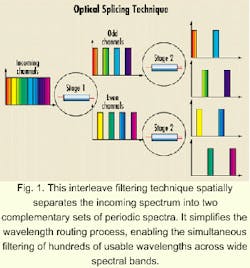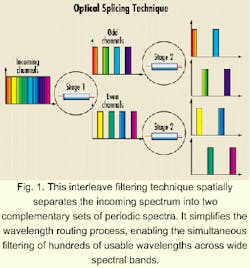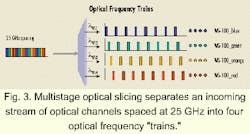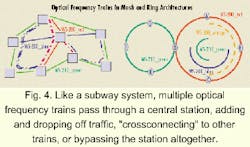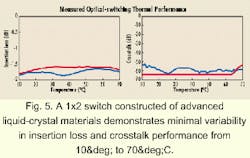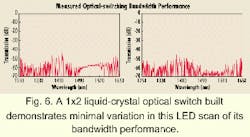Emerging switch, filtering technologies help activate the optical layer
Signal-processing and bandwidth management in the optical layer is not far off, as advances in liquid-crystal and light-polarization processing technologies pave the way to an all-optical network.
Today's optical networks carry extraordinary amounts of bandwidth. The optical layer in these networks, however, is fundamentally static and provides only simple point-to-point transport. All channel management, restoration, protection, provisioning, routing, and switching of optical channels is done in the electronic layer. This electronic-layer signal processing requires hundreds of millions of dollars in inflexible optical-to-electrical-to-optical conversions to accomplish basic bandwidth-management functions.
A number of new technologies--and subsequent network architectures--are emerging that enable active optical networks. In these networks, optical channels are dynamically routed, switched, provisioned, protected, and restored in the optical layer. Significant advances in solid-state optical switching, multiplexing/demultiplexing, and dynamic optical-signal processing are facilitating the creation of these new network architectures. Two technologies that hold significant promise are liquid crystal and light polarization-processing techniques.
Optical-system manufacturers are under tremendous pressure to introduce higher and higher capacity dense wavelength-division multiplexing (DWDM) systems. At the end of the day, the higher the capacity of a vendor's DWDM system, the more attractive it is to carriers.
Traditionally, one of the key limitations to achieving multiterabit capacity over a single fiber has been the optical-multiplexing technology. Next-generation networks must handle hundreds of channels operating at 10 Gbits/sec and higher. In order to support terabits of capacity, optical multiplexing and demultiplexing technologies must achieve the following:
- Ultra-flattop filter shape. Flattop performance is important because the 1-dB passband must be wide enough to accommodate the wider carrier signals of 10-Gbit/sec transmission. Depending upon the system architecture design, this passband requirement could be 50% of the total bandwidth or higher.
- Very high isolation. Interference from neighboring and non-neighboring optical channels can limit transmission distances and the data rates supported. As a result, channel isolation as high as 50 dB is sometimes required.
- Low loss. The lower the loss, the further the transmission distance and/or the less power amplification required.
- Modularity. With hundreds of channels now possible, carriers want to minimize the up-front investment in filters, lasers, and common equipment. Thus, a modular filtering technology is very attractive.
- Wide operating window. New fiber and amplifier technologies are making the entire band from 1300 to 1650 nm usable for DWDM applications. As a result, the filtering technology must also support this band.
- Narrow channel spacing. Very narrow channel spacing (50 GHz and narrower) must be supported to make efficient use of the operating window.
Another issue that arises with high-channel-count DWDM systems is the complexity of managing this enormous bandwidth. Several companies are developing optical protection and restoration schemes to simplify and reduce the cost of restoring the network after a system outage or fiber cut. Depending upon the application, both mesh and ring-restoration schemes are being pursued.
Mesh restoration schemes require large optical crossconnects, capable of handling hundreds or thousands of incoming and outgoing wavelengths. Ring architectures require reconfigurable or dynamic optical add/drop multiplexers.
Regardless of the architecture, there is a pressing need for a reliable and high-performance optical-switching technology.
Today, there are a number of technical approaches to all-optical switching including mechanical, polymer, thermal, lithium niobate, and acousto-optic. Most of the optical switches sold today are optomechanical, using some sort of physical movement of a mirror, for example, to switch light from one port to the next. While the performance of optomechanical switches is relatively attractive, they do not scale well to larger sizes, nor are they very reliable.
When evaluating new optical-switching technologies, several key criteria must be considered:
- Long-term reliability. To achieve "five nines of reliability" at the system level requires optical switching technology with very low failure-in-time rates.
- Low loss. Every dB is precious, and switching is no exception. While the traditional nonmechanical technologies can usually demonstrate reasonable reliability, they often have much higher loss than mechanical technologies and are thus unusable for many telecommunication-grade applications.
- Low crosstalk. To maintain transmission quality, low crosstalk between switch ports is crucial. Traditional nonmechanical switching technologies have had difficulty demonstrating acceptable crosstalk levels, where 40 or 50 dB of isolation is typically required.
- Stable performance over temperature. Any technology must be stable over temperature, either passively or through temperature control mechanisms. Nonmechanical switching technologies have had difficulty maintaining performance over temperature, often requiring precise temperature control circuitry.
- Fast switching speeds. With most applications for optical switching currently related to restoration and protection, low-millisecond switching speeds are mandatory.
- Wide operating window. Like optical filtering technologies, optical switches need to operate across the entire 1300- to 1650-nm band.
In addition to the performance requirements, the cost of major optical filtering and switching technologies is a major consideration. With optical product prices dropping between 10% to 30% annually, long-term cost reduction is critical.
Two technologies enabling ultra-dense, high-capacity, active optical networks are optical slicing techniques and liquid-crystal optical switching. Both technologies rely on a fundamental design that uses light polarization processing to switch and filter optical signals.
To overcome the performance limitations of traditional optical-filtering technologies, many companies are developing interleave filtering techniques to perform optical multiplexing and demultiplexing. One approach to interleave filtering is called optical slicing. Optical slicing spatially separates the incoming spectrum into two complementary sets of periodic spectra (see Fig. 1).Filtering 50-GHz optical signals using interference filter technology or arrayed waveguide grating technology is very difficult. By using polarization processing interleave filtering, however, channel isolation below 30 dB and 1-dB passband performance of more than 25 GHz are achieved (see Fig. 2).
Perhaps the key benefit of the optical slicing technique is it allows optical system manufacturers and carriers to adopt new network architectures to efficiently manage and route optical bandwidth.The trains can now be routed within a ring or a mesh environment (see Fig. 4). The concept is similar to a subway system, where multiple trains of different colors pass through a central station. Some are express trains and bypass the station, while others add and drop traffic at the station or "crossconnect" to other trains. This approach allows for very efficient and cost-effective bandwidth routing. A similar method can be applied to optical restoration schemes.
Liquid crystal is proving to be an excellent optical-switching technology to crossconnect and restore these optical trains. It combines the reliability of nonmechanical technologies with the high performance of mechanical switching technologies.
Historically, liquid crystal was a difficult material to use for optical switching because of two fundamental issues: performance over temperature and switching speeds. Recent advances in the technology, however, have overcome these limitations, making it ideal for bandwidth provisioning, restoration, and protection applications.Several companies now offer liquid-crystal optical-switching products for telecommunications applications. Given the attractive performance and lower cost that is now possible using this technology, it would not be surprising to see future DWDM systems built with liquid-crystal optical-switching fabrics as the core switching element.
As optical system manufacturers attempt to maintain their competitive edge, they're incorporating new technologies like optical slicing and liquid crystal in next-generation product designs. These active optical networks support multiterabits of capacity and far fewer optical to electrical conversions than is required with today's networks, driving down the cost of bandwidth for carriers, and ultimately for the end user as well.
Jian-Yu Liu is cofounder and chief technology officer and Doug Dickerson is vice president of business development at Chorum Technologies Inc. (Richardson, TX).
